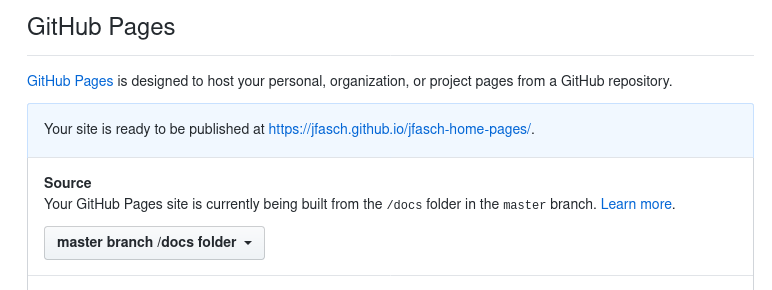Deploying Sphinx Generated Documentation to Github Pages#
Github Pages, a hosting service for static webpages, is free and easy, although run by Microsoft [1]. Times are changing.
It took me a while to figure out how to use the service properly, although, retrospectively, it hasn’t been so hard. The main points were,
Github Pages, by default, builds the stuff you push using Jekyll. I don’t use Jekyll; rather I generate my site locally, and want to upload generated content only. This is the topic of this post.
The uploaded content is then served as https://jfasch.github.io/jfasch-home-pages/. Bending things to serve it as https://www.faschingbauer.me is the topic of a companion post.
Create “Site Publication Repo”#
Important
No, we do not pollute our source repo (I refer to the local
clone as jfasch-home) with binary content, as Github
suggests. Rather, we distinguish content (which is handwritten)
from artifacts that are created during the build.
This reminds me of a company I worked for many years ago:
They had a huge pile of incomprehensible C/C++ code.
They built all that in the source tree (no, not with CMake, or Meson, or Automake or anything else that can do out-of-source builds - but with another huge pile of incomprehensible Doze
cmdcode.).They committed the build output. Yes: every build they made was a record in their version control system. The same repo that contained the source.
Effect: developers did not develop most of their time, but wait for VC operations. Rational Clearcase can be blamed for many things, but not for that.
The company does not exist anymore.
So, in parallel to the jfasch-home local copy of the upstream
Github repo, I create
another Github repo
(cloned locally as jfasch-home-pages). The intent is to use the
jfasch-home-pages/docs/ subdirectory as a deployment location
for the Sphinx-generated output from jfasch-home - one
commit/push per deployment.
Test that, by populating jfasch-home-pages with dummy HTML
content. Ah, Jekyll: we provide static files which are not source
code, technically, so we do not want Github to build our site with
Jekyll. This is what the .nojekyll file tells them to - suppress
build.
$ mkdir docs/
$ cat <<EOF > docs/index.html
<!DOCTYPE html>
<head>
<title>Dummy</title>
</head>
<body>
<p>Hmm. Appears to work.</p>
</body>
</html>
EOF
$ touch docs/.nojekyll
$ git add docs/index.html docs/.nojekyll
$ git commit -am test
$ git push
Maybe check on the Github page that the upstream content matches what we just created.
Configure Github Pages for jfasch-home-pages#
Go to the upstream deployment repo on Github, jfasch/jfasch-home-pages. Make sure you are logged in (I made that mistake and did not find the “Settings” tab :-) ). Go to the “Settings” tab.
We intend to serve content from docs/ - the Publishing Source in
Github terminology -, so select “master branch / docs folder”. Scroll
to the “Github Pages” section, and select that constellation.

Note
You will not see the “Your site is published at …” message immediately; the Github deployment machinery takes a while.
If the message appears, eventually, an innocent click on the link may lead to a 404 error. Edit the URL in the bar to explicitly add
.../index.html, or wait another few minutes for things to come in order (I do not have to understand why).
Time for Deployment#
Everything is in place now,
We have a local
$HOME/jfasch-home(say) clone (and its upstream repository that we work from)We have an upstream
https://github.com/jfasch/jfasch-home-pagesrepository; new revisions that are pushed are automatically deployed to pages.We have its local
$HOME/jfasch-home-pagesclone.
Lets perform the deployment dance for the first time; this will be repeated for all further deployments. (This cries for scripting, but that’s another story.)
Build homepage, locally, with Sphinx
$ cd $HOME/jfasch-home $ make html
(Optional) In the deployment repo, backup the
docs/CNAMEfileIf you don’t know what this is then you probably haven’t configured a custom subdomain for your Github Pages project. See here for how that works. This step can be added as an afterthough so lets omit it for now, remembering that we have to preserve the
docs/CNAMEfile once we add a custom domain.$ cd $HOME/jfasch-home-pages $ cp docs/CNAME /tmp/
Remove existing site, and copy new site
$ cd $HOME/jfasch-home-pages $ git rm -r docs/ $ cp -r $HOME/jfasch-home/_build/html/ docs/ $ touch docs/.nojekyll
(Optional) Restore
docs/CNAME$ cp /tmp/CNAME docs/
Deploy (i.e. commit and push)
$ git add --all docs/ $ git commit -am 'shiny new homepage version' $ git push
Wait a while. You may nervously poll the “Settings” tab of the upstream deployment repo if you want, until machinery is done.
Footnotes
